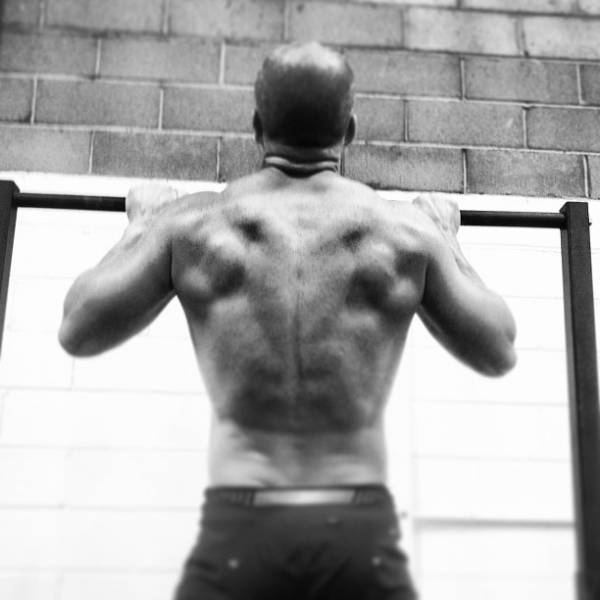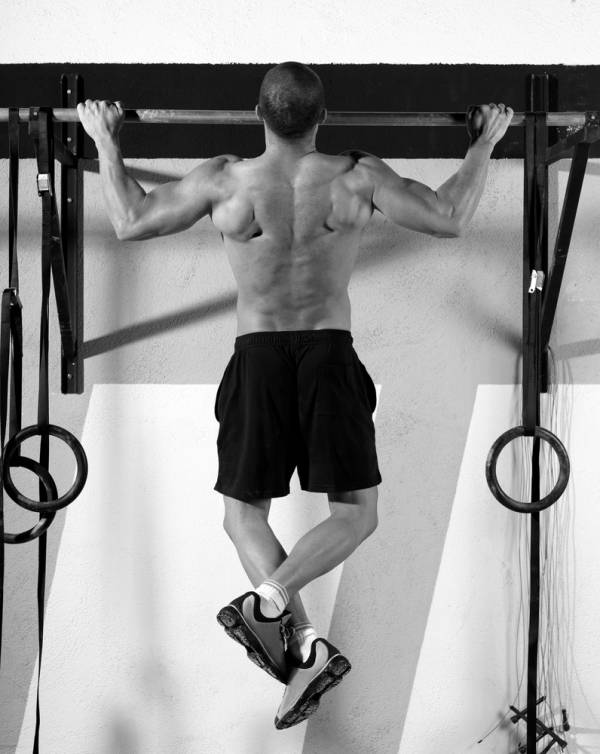One of the key things we’re working on with clients right now is their pulling strength. There are a few reasons for this. Firstly, it’s because pull ups are an awesome exercise. They work a tremendous amount of upper body muscles and also teach you to hold hollow position when done right. The ability to hold hollow position pays off in many other areas, from handstands to swimming.
Secondly, we’ve got a bunch of clients coming to us for training for Spartan Race. There are obstacles in the races such as wall climbing and rope climbs that require excellent pulling strength. And finally, have a look at the backs in the pictures below – all developed from working on pulling strength.
But many people don’t ever achieve pull ups. In the last article I wrote about pull ups, I looked at ways to isolate various problems and correct them. In this article, I’m going to give you a few substitute exercises and the reasons for using them.
One of the biggest problems people have when they first come into the gym is that they have weak posture. Their chest caves in, their upper back is rounded, and this is all caused by having become good at sitting still all day long. The problem with this is that the muscles in their upper back, which finish the pull up, are under-developed.

Going back to when I started in the industry, and there were no CrossFit gyms or other warehouse-type training facilities, the answer was simple. If people couldn’t do pull-ups, we used the lat pulldown machine. That allowed us to use much smaller percentages of bodyweight and let them gradually develop some pulling power.
But then smart guys started noticing a few things. The first thing they noticed was that although people often became crazy strong at lat pulldowns, many still lacked the ability to do pull ups. Secondly, they noticed that with just vertical pulling, people often didn’t end up with any better posture than when they started.
The reason for this is simple. The lat is an internal rotator of the arm. What this means is that when added into a routine that is press-centric, as most gym routines are, there is usually a two or three to one balance between internal and external rotation. Vertical pulling can actually make your posture worse, which is one reason I don’t emphasize it for pull up training.
But it turns out there are other drills that are even better for achieving your first pull up. Here are my top five:
1. Bent Over Rows/Batwings
Whereas vertical pulling can exaggerate bad posture, rowing makes it better. My favorite rowing drill will always be bent over rows. I am a big believer in them and know that when I do them my pull up numbers always go up quickly. The key is not to focus on just getting the bar to the bottom of the ribcage, but to hold it there for a short time, like a solid two count. Dan John has a variation of a row he calls Batwings, which is an isometric row done with longer holds, but I like to have clients use some decent weight for these.
These rows are not just a beginner exercise to build up to your first pull up, but can also be a great assistance exercise. I generally find that your row weight is a good indicator of your pull up 1RM.
2. Ring Rows
My second favorite row variation is the ring row. The added benefit with these is that not only do we get the same benefit we get from other rows – starting to reverse all the time spent in internal rotation – but we also have the benefit of teaching clients to keep their body locked together. To perform a ring row well, the body needs to stay in a straight line throughout the movement, just like it should during a pull up. I find it teaches them how hard they need to work pulling their elbows back to get their upper back working properly. Without that activation, they’ll always struggle to finish their pull-up.
3. Jumping Pull Ups
As clients start to build some more strength, we can move to the pull up bar. While they will likely still be struggling to get their first pull up, they will be able to do jumping pull ups, which can be a great first move on the bar. Simply stand under a pull up bar that you can hold onto and jump up so that you are at the top position of the pull up. Hold the top position for a two count, really focusing on squeezing your shoulder blades together and then lower down under control. Let your feet touch the ground, then jump up again and repeat the process for the desired number of reps. This takes advantage of the fact that eccentric training is far stronger than concentric training – in other words, you are much stronger while lowering a weight than you are while lifting it. A few sessions of negatives done at the right time will see someone go from having never done a pull up to achieving their first one.

4. Sled Pulling
At this point I like to add in one of two things. The first would be sled pulling. Attach a rope to a sled and pull it towards you, in hand-over-hand fashion. The key is to make sure not just to pull with your arms. Instead, just like with the rows, focus on pulling your arm as far back behind you as you can. The sled can be a good transition to hard pulling work, as it’s possible to load it with as much or as little weight as needed.
5. Rope Climbing
The next step to develop some great arm strength is rope climbing. Remember, though, that we’re doing this to develop our pull up strength. Just like we used eccentric training to quickly boost strength with the jumping pull up idea, we can do the same with rope climbing. We’re not even going to worry about climbing the rope – just use your feet and climb in the most energy-efficient manner possible. Once you get to the top of the rope, I want you to come down using only arm strength. This is a great way to build both the grip and arm strength required for strong pull ups.
At each stage along the way, there are more ways we can look to fix the weak links via added isolated work. Remember isolation exercises are not evil or non-functional if they help you perform better.
And now we’ve arrived at the final key to the first pull up puzzle: bodyweight. Even dropping a few pounds can make a massive difference in your ability to get your first pull up. So perhaps the first exercise needed for pull up success is a push to get away from the dessert buffet.






